Spiders in the genus Latrodectus are commonly referred to as widow spiders. They belong to the family Theridiidae and have shiny black or dark brown bodies with red, orange, or white markings on the underside of their abdomens. Distributed widely, these spiders are. Found in various parts of the world, they are. Of the 30 + species of spiders in the genus Latrodectus, only five call North America home: the Northern black widow, the Southern black widow, the Western black widow, the brown widow, and the red widow. Female widows are venomous spiders, and their bites can be medically significant. Continue reading to discover 11 types of widow spiders throughout the world!

All widow spiders belong to the family
Theridiidae. Most have shiny black or dark brown bodies with red, orange, or white markings on the underside of their abdomens.
©Jeff Cleveland/Shutterstock.com
Widow Spiders
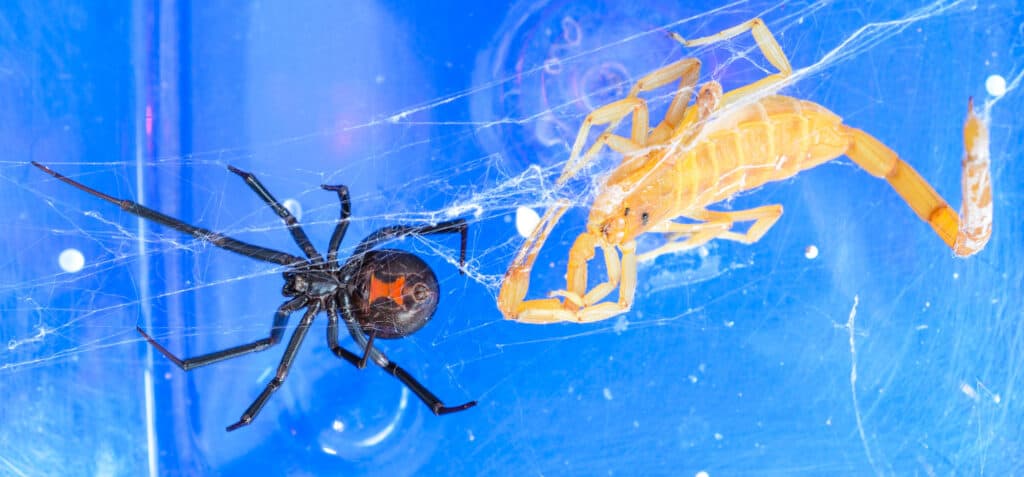
In their their webs widow spiders catch insects, on which they feed.
©James C. Bartholomew/Shutterstock.com
Known for their irregular, tangled webs, often constructed in dark, sheltered locations, widow spiders are. These include garages, woodpiles, and outdoor structures. They are not aggressive spiders and typically only bite when provoked or threatened. Females [average 1.5 inches (3.8 cm)] are much larger than males [0.75 inches (2 cm)]and have the characteristic red or orange hourglass marking, generally on the underside of their abdomens. Their bites are toxic. Their venom contains neurotoxins that affect the nervous system. While their bites can be painful, they are rarely fatal to healthy adults. However, individuals who are young, elderly, or have compromised immune systems may experience more severe reactions. The smaller males may have colorful markings on their dorsal (upper) abdomen. Their bites are not harmful to humans.
Mating Behavior
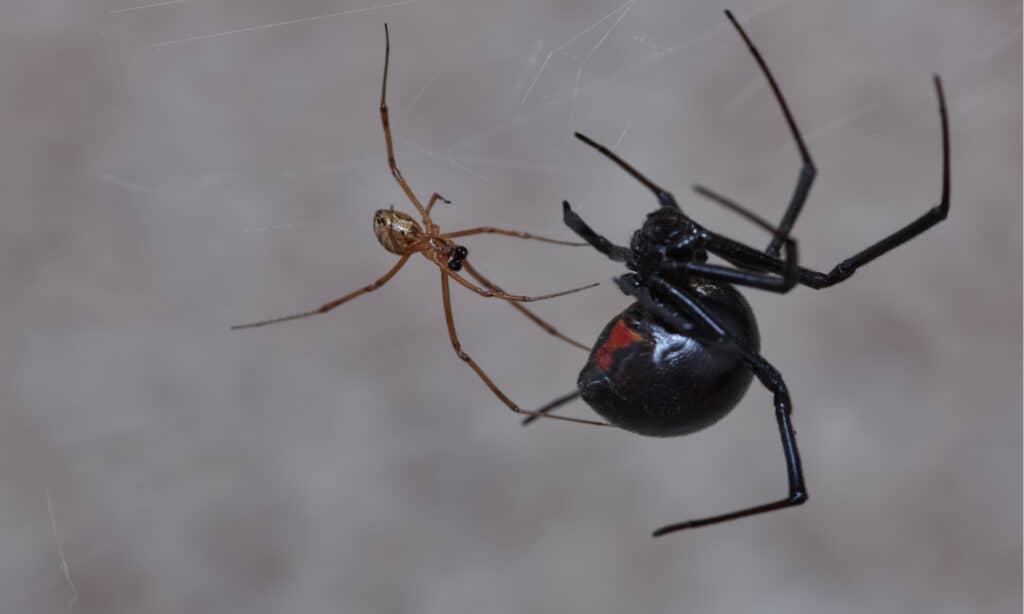
Widow males are much smaller than females. Their bites are not harmful to humans.
©lighTTrace Studio/Shutterstock.com
Renowned for their peculiar mating behavior, widow spiders are. Males must perform a courtship ritual to approach the larger, potentially cannibalistic females. If successful, they deposit their sperm in the female’s reproductive tract. After mating, females may consume the males. However, many males live to mate again. While widow spiders are often associated with the notion of females devouring their mates after mating, it’s important to dispel the myth surrounding this behavior. While instances of sexual cannibalism do occur, they are not as common as popular culture might suggest. In reality, a significant proportion of male widow spiders survive the mating process, and many have evolved various strategies to increase their chances of avoiding being consumed.
Lay their eggs in silk egg sacs, widow spiders do. Protected by the web her egg sacs are. These egg sacs contain hundreds of eggs. Young spiders, known as spiderlings, hatch from these sacs.
Widow spiders are carnivorous. In their their webs they catch insects, on which they feed. It’s crucial to exercise caution when dealing with female widow spiders. If bitten by a female widow spider, it’s advisable to seek medical attention
Discover 11 Types of Widow Spiders Throughout The World: Northern Black Widow
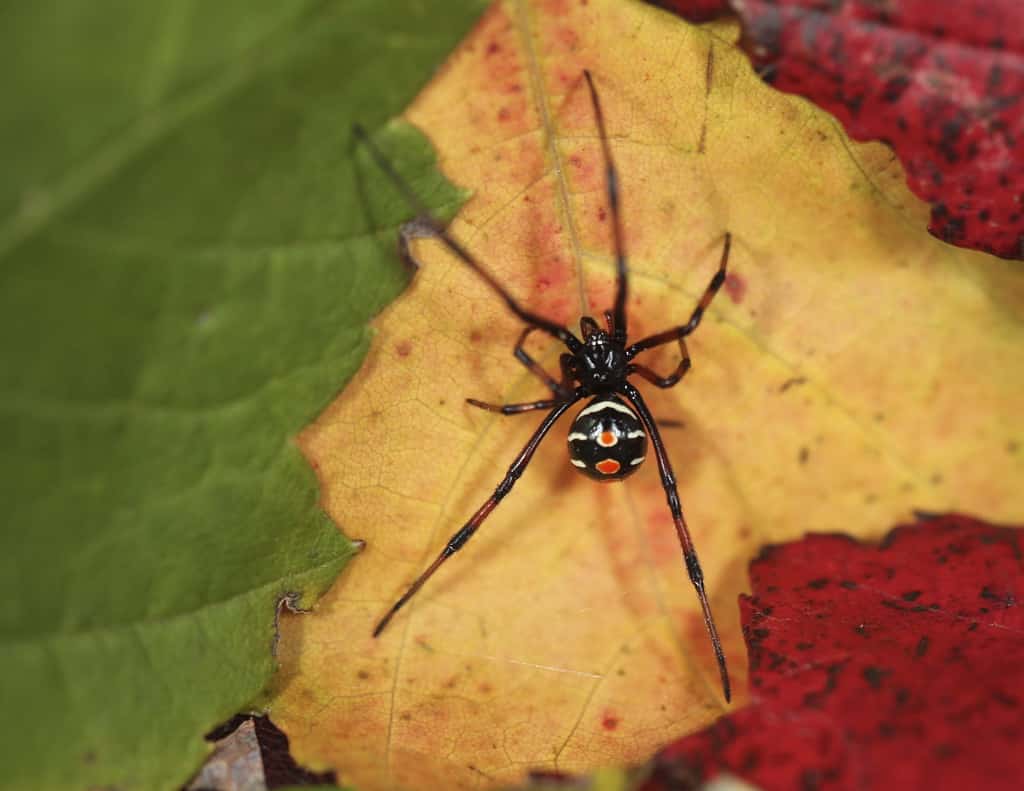
Northern black widow spider (
Latrodectus variolus) found in colored fall maple tree leaves.
©iStock.com/NajaShots
The Northern black widow spider, Latrodectus variolus, is a venomous spider found throughout North America, along the Eastern Seaboard, from Southern Canada south to Florida, and west to Texas. The female Northern black widow is similar in appearance to the more widely recognized Southern black widow (Latrodectus mactans). It is typically black with a distinctive red or orange hourglass-shaped mark on the underside of its abdomen. The male Northern black widow is smaller and less colorful, often displaying red or white markings on a grayish-brown background. Northern black widows are found in natural outdoor habitats, like woodlands, gardens, and forests, and can also be encountered in more urban settings. They tend to prefer dark and sheltered locations, including woodpiles, rock crevices, and even buildings’ basements or crawl spaces.
The Northern black widow’s venom contains neurotoxins that can affect the nervous system. While their bites are usually not fatal to humans, they can cause severe pain and muscle cramps. Medical attention is advisable to manage these symptoms. Northern black widows are not aggressive and will only bite in self-defense. They are reclusive in nature and tend to stay hidden. These spiders primarily feed on insects that become ensnared in their webs.
Discover 11 Types of Widow Spiders Throughout The World: Southern Black Widow
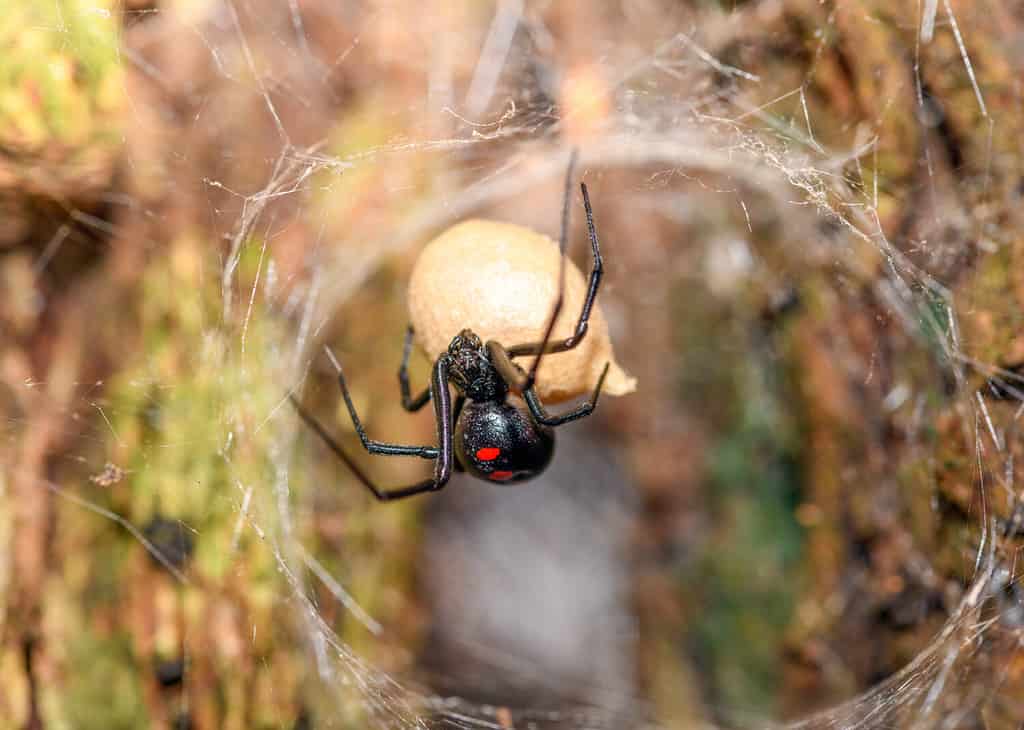
Southern black widow spiders are generally not aggressive and will only bite in self-defense.
©Jeff W. Jarrett/Shutterstock.com
The Southern black widow spider, scientifically known as Latrodectus mactans, is a venomous arachnid found in the United States. The female Southern black widow is the most recognized and studied of the species due to its venomous bite. They are typically shiny black with a distinctive red or orange hourglass-shaped mark on the underside of their abdomen. The males, on the other hand, are smaller and lighter in color, with various red and white markings.
Southern black widows prefer dark and sheltered locations. They are often found in outdoor spaces like sheds, barns, woodpiles, and under eaves, as well as in more urban environments, such as garages and crawl spaces. The venom of the Southern black widow is potent, and it contains neurotoxins that can affect the nervous system. While their bites are rarely fatal to humans, they can cause severe pain and muscle cramps. Symptoms typically subside within a few days.
These spiders are generally not aggressive and will only bite in self-defense. They are more reclusive in nature and tend to hide in their webs. When disturbed, they may display a defensive posture by hanging upside down and exposing their red hourglass mark. Southern black widows primarily feed on insects that become trapped in their irregular, three-dimensional webs.
Distribution

To avoid encounters with Southern black widows, it’s advisable to wear gloves when reaching into dark or sheltered spaces.
©Sari ONeal/Shutterstock.com
As the name suggests, the Southern black widow is commonly found in the Southeastern United States, However, its range is extensive, stretching to Nebraska in the west and Illinois, Indiana, and Ohio to the north. To avoid encounters with Southern black widows, it’s advisable to wear gloves when reaching into dark or sheltered spaces. Additionally, keeping your surroundings clean and free of clutter can help reduce the likelihood of encountering these spiders. If bitten, seeking medical attention is recommended.
Discover 11 Types of Widow Spiders Throughout The World: Western Balck Widow
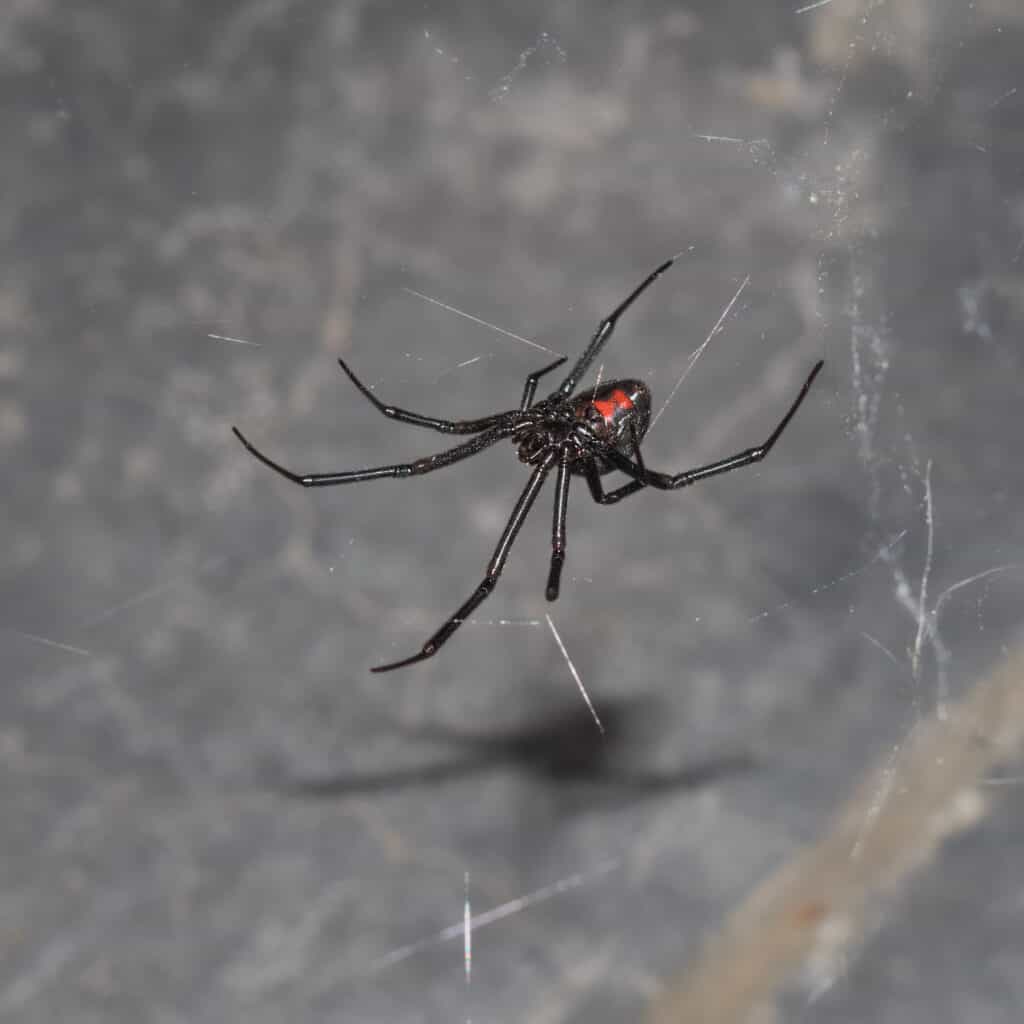
Widely distributed in the United States, ranging from the Pacific coast to the Central and Southern states, Western black widow spiders are.
©iStock.com/Shravan Sundaram Photography
Found in Western North America is the venomous species Latrodectus hesperus, the Western black widow. Easily recognized by its glossy black or dark brown body with a distinctive red or orange hourglass-shaped marking on the ventral (under) side of the abdomen, it is. This hourglass marking is a key identifying feature. Males of this species are smaller and typically have lighter markings, but they lack the vivid red coloration.
Widely distributed in the United States, ranging from the Pacific coast to the Central and Southern states, Western black widow spiders are. They inhabit a variety of environments, including deserts, forests, grasslands, urban areas, and outdoor structures. They often build irregular, tangled webs in sheltered locations. Their silk is one of the strongest natural silks. They feed on cockroaches, earwigs, beetles, flies, and even other spiders The females of the species have venom that contains neurotoxins.
Bites from this spider can be painful and may result in localized symptoms, including muscle cramps, sweating, and nausea. While bites can be uncomfortable, severe reactions are relatively rare, and fatalities are exceedingly rare. Western black widow spiders, while often feared due to their venom, play a role in controlling insect populations and are an important part of the ecosystem. Proper education and awareness can help dispel misconceptions about the dangers of these spiders and promote coexistence.
Brown Widow
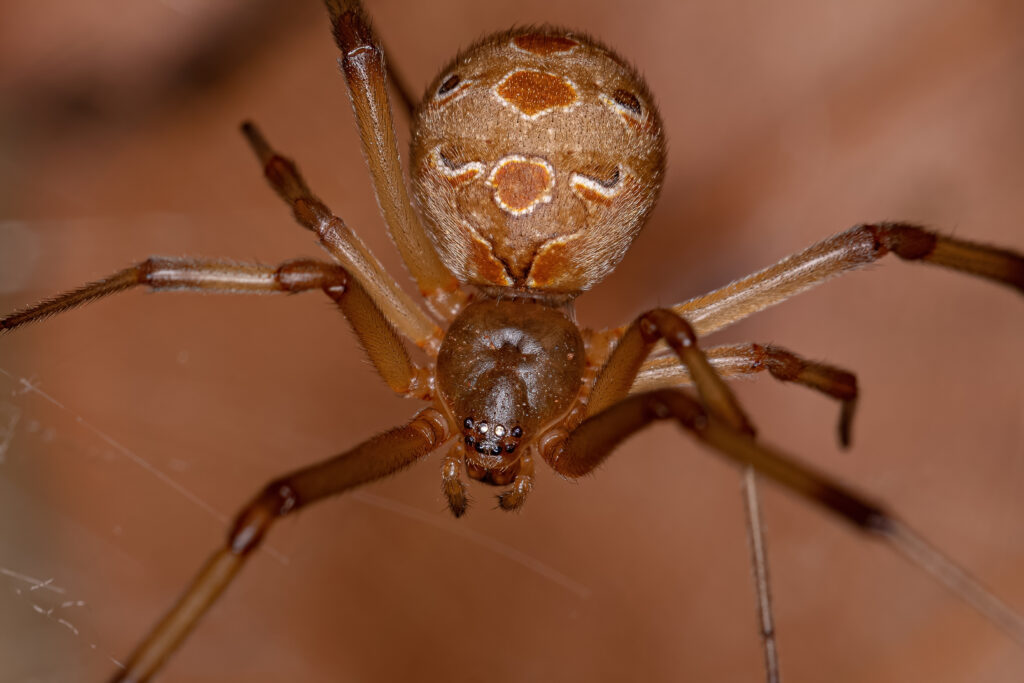
©iStock.com/ViniSouza128
A species of widow spider found in various parts of the world, primarily in tropical and subtropical regions the brown widow (Latrodectus geometricus) is. Medium-sized and varying from light brown to dark brown or gray, brown widow spiders are. They have a somewhat similar body shape to other widow spiders but lack the classic red hourglass marking. Instead, they often have a series of distinct geometric patterns on the dorsal (upper) side of their abdomen, which is where their common name, “geometric button spider,” originates.
From South Africa to Japan, Latrodectus geometricus is widely distributed. It lives in tropical and subtropical regions. They often inhabit urban and suburban areas, including gardens, parks, and outdoor structures. Their adaptable nature allows them to thrive in a range of environments.
Brown widow spiders possess neurotoxic venom similar to other widow spiders. Bites from this spider can be painful and may result in localized symptoms. Brown widow spiders are interesting in their adaptability to urban and suburban environments, where they play a role in controlling insect populations. While they are venomous, bites are rarely life-threatening, and proper education and awareness can help mitigate fears and misconceptions about these spiders
Discover 11 Types of Widow Spiders Throughout The World: Red Widow

Found in sandhill and scrub habitats in Florida, red widow spiders are.
©Florida Division of Plant Industry Archive / CC BY 3.0 US, via Wikimedia Commons – License
A species of widow spider found in certain parts of Florida, particularly in the Southern and Central Regions, Latrodectus bishop, is the red widow. Named after its distinctive red coloration, which sets it apart from the more familiar black widow, as its common name suggests, the red widow spider is. The female typically has a shiny red or reddish-brown abdomen with a row of red dots or markings on the underside. These red markings can sometimes resemble an hourglass shape, although they vary in appearance from one individual to another. Males of this species are generally smaller and are not as brightly colored as the females. Primarily found in sandhill and scrub habitats in Florida, red widows are.
Like other Latrodectus species, female red widow spiders possess venom with neurotoxic properties. Their bites can be painful and may cause various symptoms, such as localized pain and cramping. The bites from red widow spiders are rare. Encountered in human living spaces, these spiders are not.
Known to be secretive and reclusive, red widows are. They tend to construct irregular webs close to the ground or in low vegetation, where they capture prey.
Latrodectus Katipo
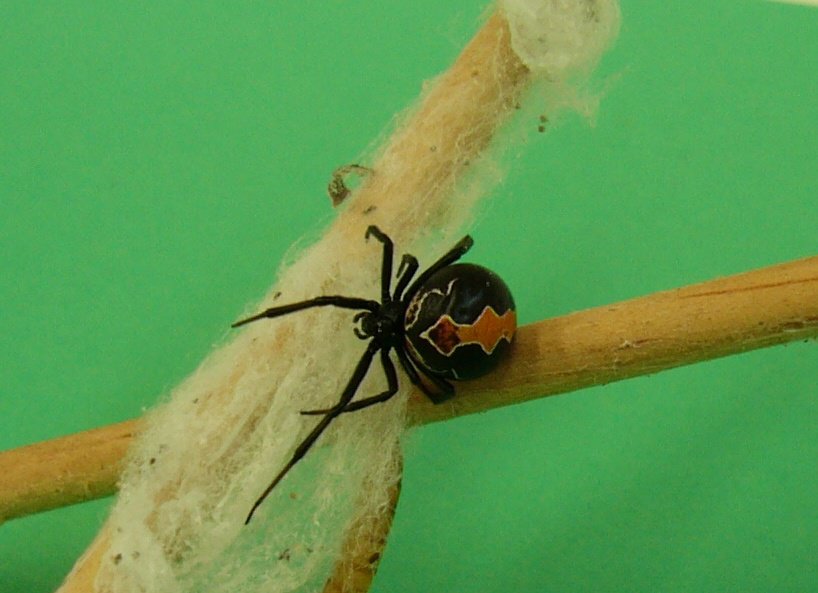
Known for its striking black and red coloration, the katipo spider is.
©jesscostall / Creative Commons 2.0 – License
Latrodectus katipo, commonly known as the katipo, is a venomous spider native to New Zealand. It is one of the country’s few native spiders and is related to the widow spiders, including the black widow. The katipo is a relatively rare and secretive spider. It is a small to medium-sized spider with a predominantly black body. One of its most distinctive features is a red or orange stripe on the dorsal (upper) side of the abdomen. This marking can vary in shape, with some individuals displaying an hourglass-like pattern similar to other widow spiders.
Found in coastal areas of New Zealand, particularly in sand dunes, coastal vegetation, and beach habitats, Katipo spiders are. Adapted to these environments, they construct silk webs in sheltered locations like sand burrows and driftwood. Katipo spiders produce venom that contains neurotoxins, similar to other widow spiders. Their bites can be painful and may cause symptoms such as localized pain, muscle cramps, sweating, and nausea. While bites can be uncomfortable, they are rarely life-threatening, and antivenom is available.
Considered an endangered species in New Zealand, the katipo spider is. Habitat destruction, and predation by introduced species, among other factors, have contributed to the decline of this spider. Conservation efforts are in place to protect its remaining habitats.
White Widow Spider
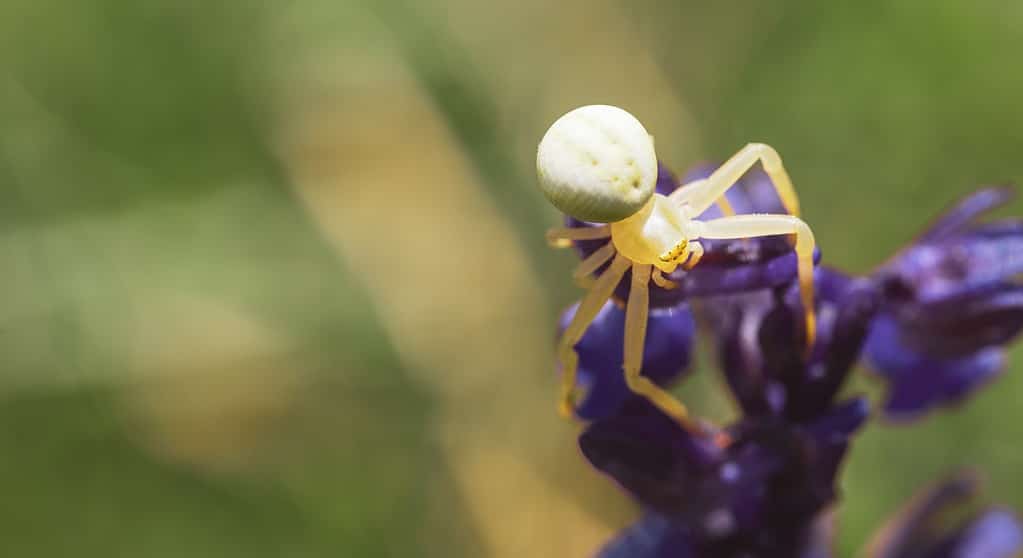
The white widow spider lacks the typical black or dark brown coloration of most widows.
©Chaykoi/Shutterstock.com
A species of widow spider found in parts of North Africa, the Middle East, and the Mediterranean, the white widow spider (Latrodectus pallidus) is. It is closely related to other widow spiders but is distinct in appearance. Known for its relatively small, pale-colored body, the white widow spider is. Unlike many other widow spiders, it lacks the typical black or dark brown coloration. Instead, it has a light tan or brownish color. The abdominal markings can vary and may include pale yellow, white, or beige patterns on the dorsal (upper) side, which may resemble various shapes, including chevrons or stripes.
Typically found in its native range, Latrodectus pallidus is. This includes parts of North Africa, including Egypt, Tunisia, and Algeria. The white widow also calls the Middle East (Israel, Lebanon), and some Mediterranean regions home. The white widow spider prefers warm and arid environments. Encountered in outdoor habitats, gardens, and urban areas, it is. Like other widow spiders, the white widow spider possesses venom that contains neurotoxins. Bites from this spider can be painful and may result in localized symptoms, such as muscle cramps, sweating, and swelling. Severe reactions are relatively rare, and fatalities are practically unheard of.
Discover 11 Types of Widow Spiders Throughout The World: European Black Widow
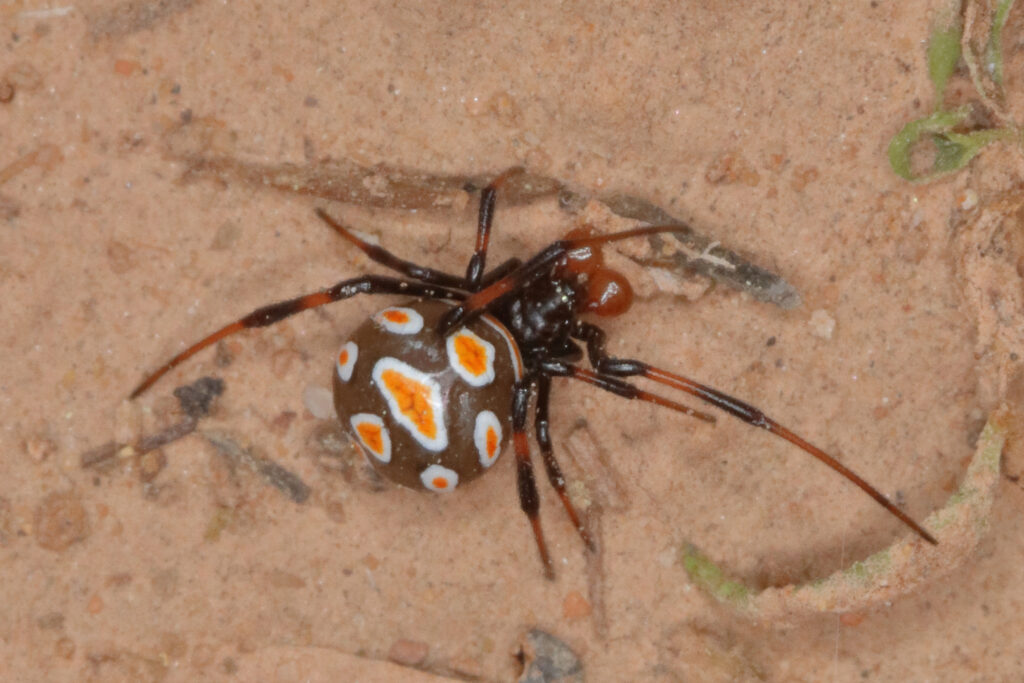
The European black widow is sometimes called the Mediterranean black widow.
©iStock.com/Frank Buchter
Latrodectus tredecimguttatus, commonly known as the European black widow or the Mediterranean black widow, is a species of widow spider found in parts of Europe and North Africa. It is one of the few representatives of the genus Latrodectus found in Europe. The European black widow is a relatively small species of widow spider [0.28–0.59 inches (7–15 mm)] with a black, shiny body. It is characterized by 13 white or yellowish spots on its abdomen, which are often arranged in a distinct pattern, contributing to its scientific and common name. Tredecimguttatus is Latin for thirteen-spotted. This characteristic marking sets it apart from other widow spider species.
Latrodectus tredecimguttatus is typically found in Mediterranean regions, including parts of Southern Europe and North Africa. It prefers warm, dry environments and is often found in areas with low vegetation, rocks, and debris. It can be encountered in a variety of habitats, including scrublands, vineyards, gardens, and coastal areas. The European black widow’s bite contains neurotoxins. While their bites can be painful and may cause localized symptoms such as pain and swelling, severe reactions are relatively rare, and fatalities are exceptionally rare. Nonetheless, individuals bitten by Latrodectus tredecimguttatus should seek medical attention. Though the European black widow is not as well-known as its North American relatives, is an interesting species with a distinctive appearance and behavior.
Brazilian Widow Spider
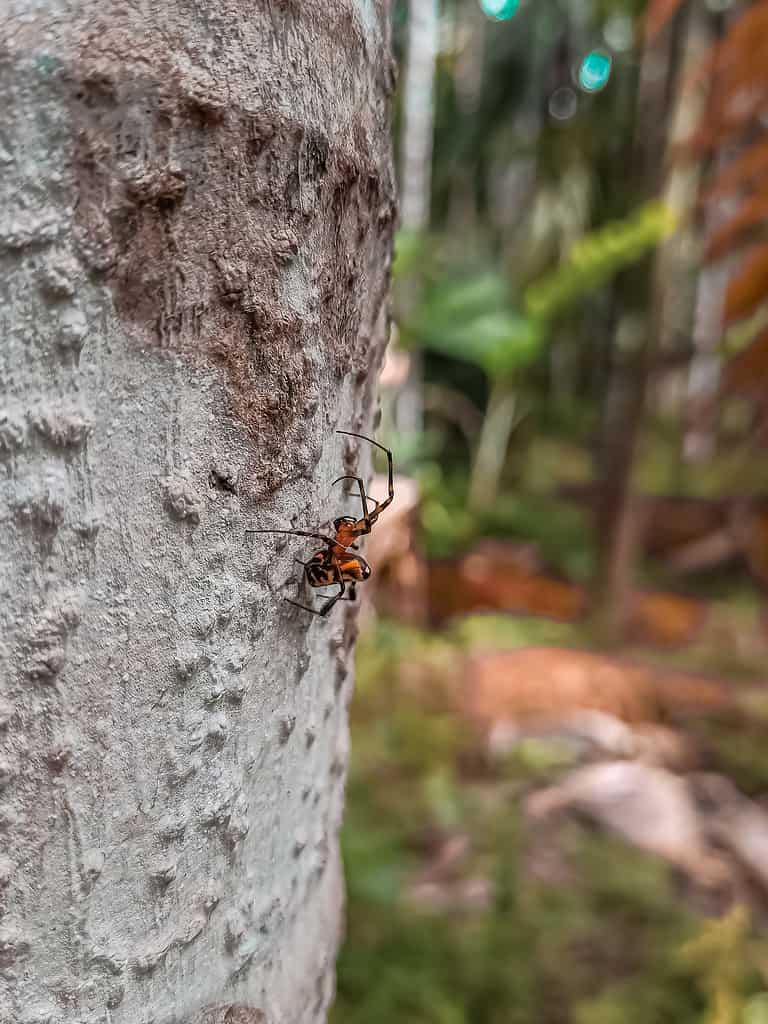
©KA15ARJUN/Shutterstock.com
The Brazilian widow spider (Latrodectus corallinus), is a species of widow spider found primarily in South America, principally in Brazil. It is closely related to other widow spiders and is known for its distinctive appearance. The Brazilian widow spider is a relatively small spider with a shiny black body. It has a reddish or coral-red hourglass-shaped marking on the ventral (under) side of the abdomen. The red marking can be vivid and striking. Latrodectus corallinus is found in South America, especially Brazil, and parts of Argentina, Paraguay, and Uruguay, as well. It prefers warm and tropical environments, and it often resides in habitats such as forests, gardens, and areas with dense vegetation.
Like other widow spiders, the Brazilian widow spider’s venom has neurotoxic properties. Bites from this spider can be painful and may result in localized symptoms, including muscle cramps, sweating, and nausea. Brazilian widow spiders should generally be left undisturbed in their natural habitats.
Discover 11 Types of Widow Spiders Throughout The World: Australian Redback Spider
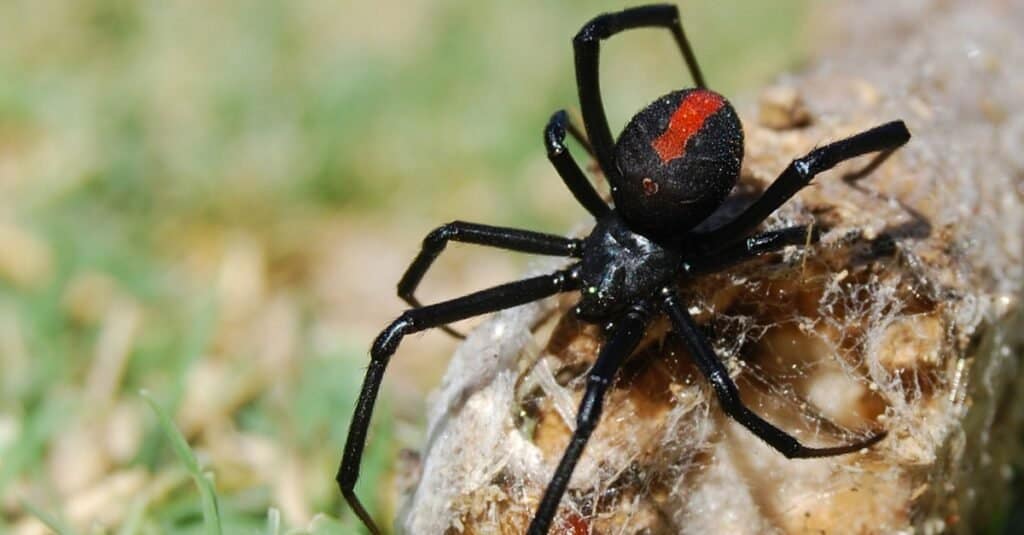
The deadly poisonous Australian
Redback Spider
, Black Widow, Latrodectus hasselti, whose bites can be deadly.
©iStock.com/maria72
Latrodectus hasselti, the Australian redback spider, is a venomous spider species found primarily in Australia. Redback spiders are easily identifiable by their small to medium-sized bodies [0.60 inches (1.5 cm)], which are usually black with a distinctive red or orange hourglass-shaped marking on the top of the abdomen. The redback’s shiny black coloration and the bright red marking serve as a warning to potential predators.
Redback spiders are found throughout Australia and are well-adapted to a variety of habitats, including urban areas, gardens, sheds, and outdoor structures. They often build irregular, tangled webs in sheltered locations, such as crevices, under rocks, and in vegetation. Redback spiders have venom that contains neurotoxins, which affect the nervous system. Their bites can be painful and may cause localized pain, muscle cramps, sweating, and nausea. While bites can be uncomfortable, they are rarely life-threatening, and antivenom is available for severe envenomations.
Latrodectus umbukwane

©Luke.Verburgt, CC BY 4.0 – License
The Phinda button spider (Latrodectus umbukwane), is a species of widow spider recently discovered in South Africa. It has an exceptionally small distribution, limited to the endangered lowland sand forest biome of Northern KwaZulu-Natal. It is a member of the Latrodectus genus, which includes some of the most venomous spiders in the world. And like other widow spiders, the Phinda button spider possesses venom that is potentially dangerous to humans. While their bites are not usually fatal, they can cause significant discomfort and symptoms. The venom can affect the nervous system and may lead to pain and muscle cramps.
Female Phinda button spiders [ 0.20-0.35 inches (5.5mm-9.0mm)] are typically larger than males and are recognized by their distinctive black coloration with a red, orange, or yellow hourglass-shaped mark on the underside of their abdomen. The male Phinda button spider, like other widow spiders, is much smaller and less colorful. These spiders are often found in natural outdoor habitats, such as grasslands and scrublands. The Phinda button spider constructs a tangled web in which to capture prey. They are known to be reclusive and non-aggressive. They only when startled or in self-defense.
The photo featured at the top of this post is © Sari ONeal/Shutterstock.com
Thank you for reading! Have some feedback for us? Contact the AZ Animals editorial team.






